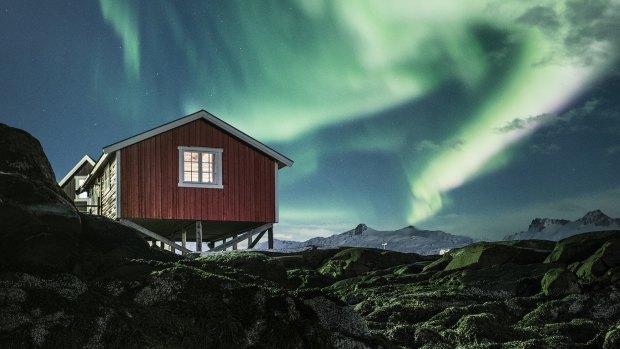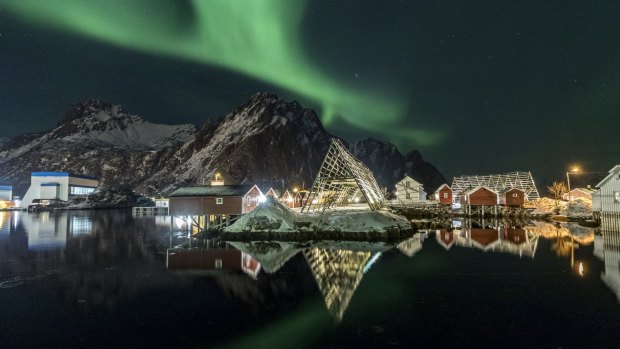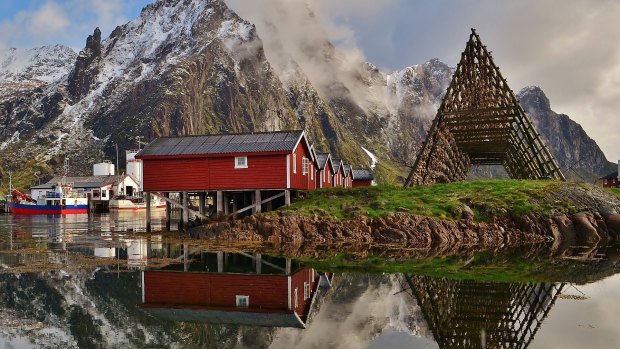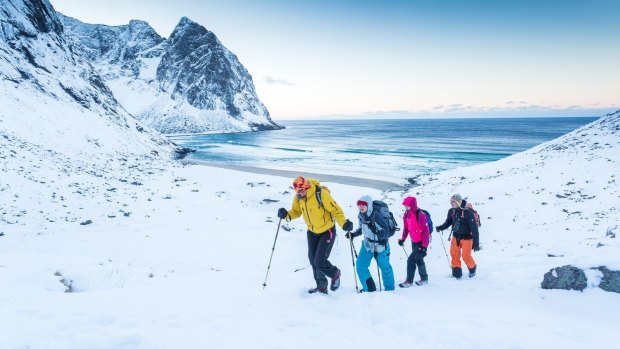This was published 4 years ago
Norway, Lofoten Islands: See icy vistas in this Arctic Circle archipelago while staying in rorbu cabins
By Mark Daffey

One of the 38 standalone cabins at Svinoya Rorbuer.Credit: Wouter Boer
It's said that you can have sun for breakfast, storms for lunch and calm seas for dinner in Norway's Lofoten Islands. That's how changeable the area's weather is.
But the Norwegians have another saying: "There's no such thing as bad weather, only bad clothing", suggesting that nothing should stop you from going outside provided you're appropriately dressed. I imagine winter hurricanes might be an exception to that rule. And I can assume that because I've just been through one.
My arrival at the Lofoten Islands port of Svolvaer was delayed by 24 hours due to 180km/h hurricane winds that forced my Hurtigruten ferry to reroute to the mainland port of Ornes, further south, before backtracking once the seas had calmed. Thankfully, my hotel accommodation in one of the Svinoya Rorbuer's 38 standalone cabins is one of the cosiest I've ever stayed in.

The Svinoya Rorbuer hotel is a cluster of cosy cabins modelled on traditional fishermen's accommodation.Credit: Odd-Petter Tanke Jensen
The cabins, called rorbu, were originally built to shelter members of the local fishing community. Mine, a rustic, single-room rorbu, was the town school. The hotel reception served as the general store as far back as 1828, with the adjoining bar and restaurant warehousing excess stock. Others functioned as homes during the cod-spawning season from February to April each year, when huge schools gather offshore. And just outside my front door is a towering cod drying rack that's several storeys high. It's one of several I see next morning on the island of Svinoya.
After a particularly restful night's sleep, I walk through the town of 4500 residents – the archipelago's largest settlement – to collect my hire car from the Vestfjorden Hotel. I'm handed the keys to a manual left-hand drive Hyundai i20. Since I've never driven on icy roads before, I'm justifiably nervous. So I add full insurance cover to my quote then set off south along the E10 highway, intent on salvaging what's left of my stay on the islands after my wasted day at sea.
The E10 starts in the Swedish city of Lulea, on the Gulf of Bothnia, then twists and turns for 850 kilometres through some of the most amazing scenery imaginable. It eventually terminates in A, the southernmost village in the Lofotens on the island of Moskenesoya, and it's here, 133 kilometres from Svolvær, that I plan to reach before the day's end.

Norways' Lofoten IslandsCredit: Svinoya Rorbuer
I proceed cautiously, puttering along until I've gained a better feel for the road's slippery surface and my vehicle's unfamiliar layout. After passing beneath Norway's second-largest wooden church on a hill in Kabelvag, the oldest fishing village in the Lofotens, just south of Svolvaer, I'm struck by the multitude of people out making the most of the settled weather. Perhaps because it's the weekend, cross-country skiers and joggers are out in force. Kids sled down icy hillsides and skate on frozen ponds. Mothers bundle rugged-up infants into pushers for strolls around town with friends. Couples walk their dogs.
The people I've spoken to so far in the Lofotens, and further north in and around the university city of Tromso, unequivocally cite the weather as an influencing factor that helped them decide to live inside the Arctic Circle. To them, the climate's volatile nature is one of the region's most appealing qualities.
"It's never boring," my hotel receptionist had said earlier in the day. "I can't imagine living anywhere else." She told me she embraced the storms and the cold whenever they came, "but I love summer here just as much."

Hiking at Kvalvika, Lofoten.Credit: Alex Conu/visitnorway.com
Beyond Kabelvag, I continue on through Leknes to Ramberg, where cod drying racks tower over a snow-dusted beach. In summer, Ramberg's sweeping sands would attract swimmers and surfers. In winter, it lures photographers.
The dozen or so photographers lumbering heavy cameras mounted on sturdy tripods to the water's edge in Ramberg aren't the first I've seen today. Winter photography tours to the Lofotens have proven to be extremely popular in recent years, and I've noticed several groups pile out of minivans and cars, practically tripping over one another in their haste to get their desired shot.
The reasons are obvious. The adorable rorbus, grouped together by the waterside all over the islands, are naturally photogenic. So too are the cod drying racks, especially in places like Ramberg's scenic beach. Knife-edged mountains slope towards inlets harvesting Atlantic salmon, and to dramatic fiords where fishing trawlers motor silently back to port after days spent at sea. And in winter, there's always the chance to capture the northern lights, splayed across the skies in swirls of colour.
It makes me rue the unfavourable turn of weather two days earlier even more. With the extra day, I'd have been able to detour down side roads leading to snug fishing harbours such as Nusfjord or Ballstad, and to the towns of Vikten and Sund, on the island of Flakstad. Hikers, wind surfers and climbers favour the north coast of Vestvagoya, particularly around Unstad and Eggum.
I also discover on my final morning, while checking out of my hotel, that two Norwegian surfers who rode the winter swells for months on end while living in a lean-to they'd built using flotsam and jetsam found on the beach, had based themselves at Kvalvika, an isolated beach on Moskenesoya. I'd thoroughly enjoyed watching their adventures when the film they made toured the world as part of the Banff Adventure Film Festival several years back. With more time, I'd have hiked across the snow-covered fields as a pilgrimage of sorts, to see the bay for real.
My favourite area along the E10 is way down south, around the exceedingly picturesque town of Reine, once voted the most beautiful place in Norway. But photographers plague it, too. When I walk onto a timber bridge into town with camera in hand, aiming to capture the scene of a row of rorbu cabins beneath a mountainous backdrop, six other photographers are already lined up ahead of me. One even barks at me to stop; his image, he explains, will be blurred by the vibrations caused by me walking on the bridge.
My Lofotens drive ends in the village of A. The sun has already disappeared for the day but its colours still linger.
As I gaze out to sea, to where clumps of silhouetted islets form a jagged horizon, the waters are calm. Tomorrow, no doubt, will bring sun, and then storms. There may even be a hurricane. But that's how they like it here, in the Lofotens.
FIVE STUNNING ARCHIPELAGOES
HAWAII
The volcanic archipelago in the Pacific is justifiably renowned for its thumping surf, frequent eruptions, rugged coastlines, rain-soaked interiors and an easy-going "aloha" lifestyle.
TIERRA DEL FUEGO
Separated from mainland South America by the Strait of Magellan, this windswept string of islands is often compared to Alaska or Norway because of its many fiords and glaciers.
SEYCHELLES
These idyllic tropical islands in the Indian Ocean, off the east coast of Africa, are known for their white sand beaches, crystal clear waters and striking granite boulders.
SOUTH SHETLAND ISLANDS
The 11 major islands wrapped around the northern tip of the Antarctic Peninsula include the otherworldly Deception Island, a sunken caldera that is one of just two active volcanoes in Antarctica.
MARQUESAS
French post-impressionist painter Paul Gauguin and Belgian singer Jacques Brel spent their final years living in French Polynesia's most remote island group, which similarly inspired novels by Robert Louis Stevenson and Herman Melville.
TRIP NOTES
MORE
TOUR
50 Degrees North specialises in innovative and authentic travel experiences in the Nordic region, including the Lofoten Islands. See fiftydegreesnorth.com
FLY
Finnair flies to Helsinki from Australia in partnership with Qantas and other airlines, with daily flights from Oslo connecting with the Lofoten Islands. See finnair.com/au
STAY
Original fishermen's cabins at Svinøya Rorbuer cost from $215 a night, depending on the season and size of cabin. See svinoya.no
Mark Daffey travelled courtesy of Finnair and 50 Degrees North.
Sign up for the Traveller Deals newsletter
Get exclusive travel deals delivered straight to your inbox. Sign up now.